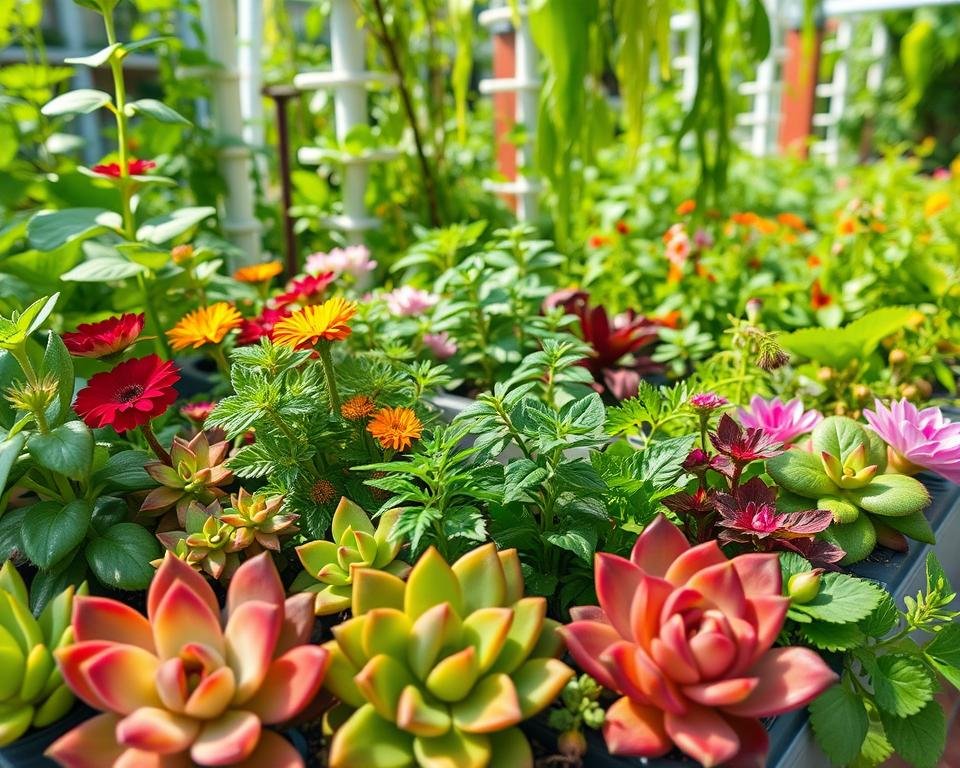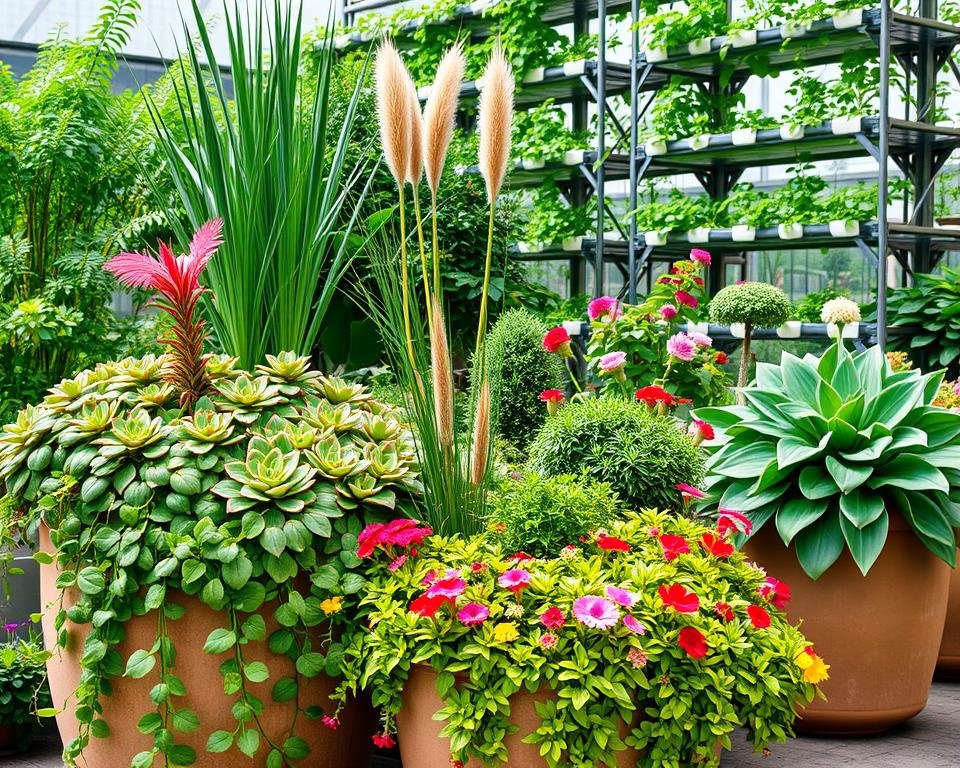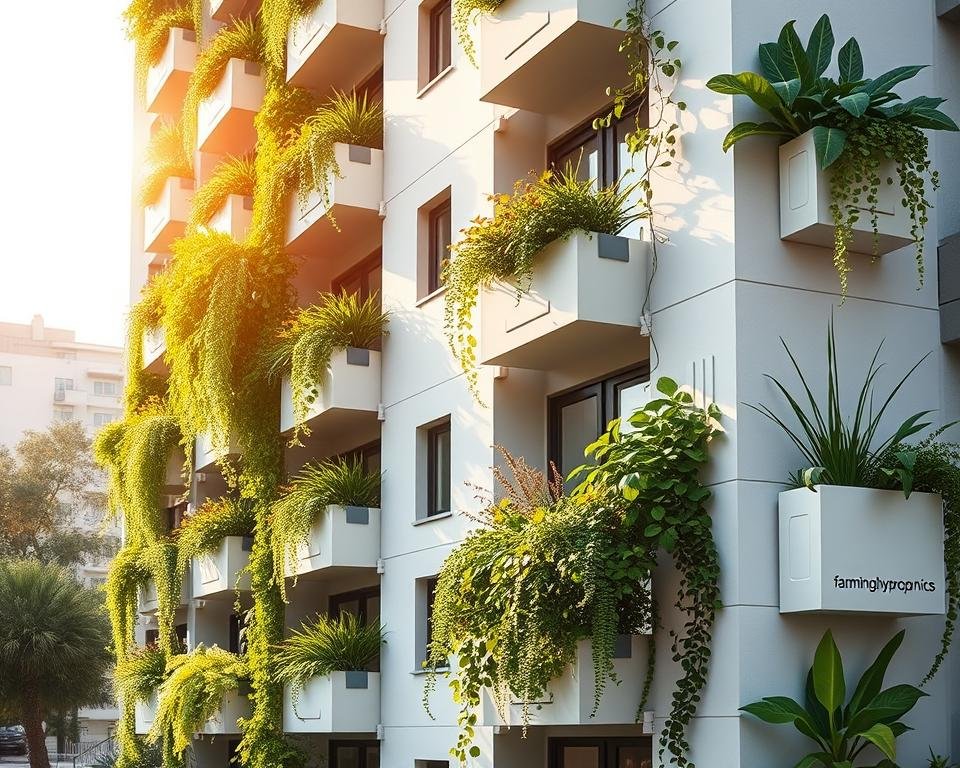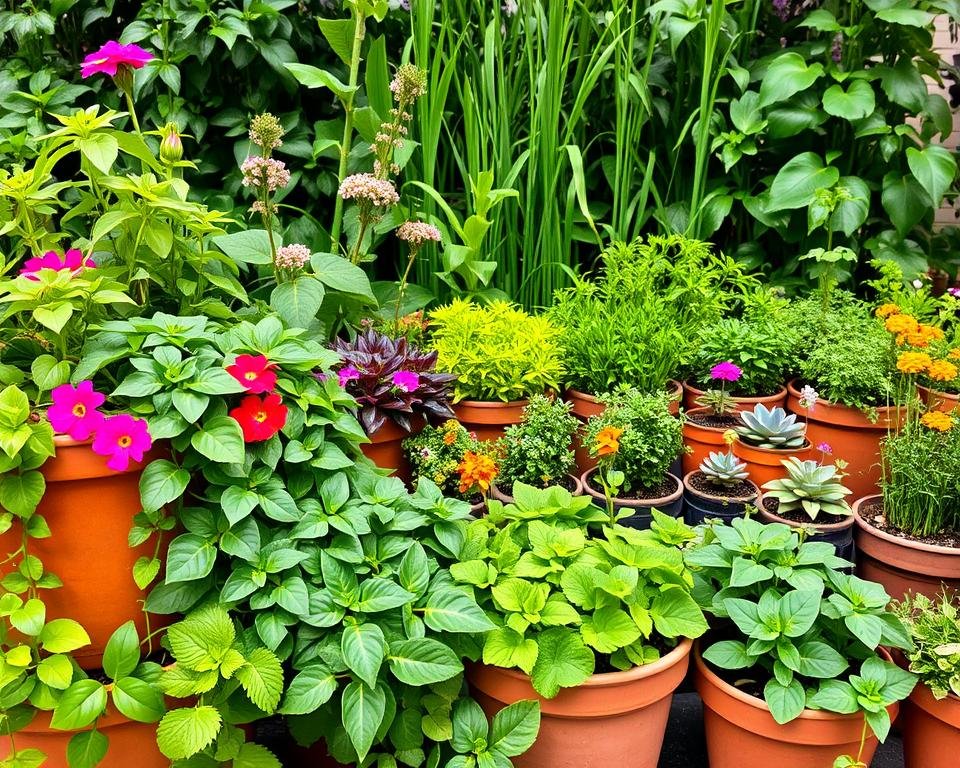Plant Selection Tips for Container Gardening
Imagine turning your small balcony or patio into a lively garden. Container gardening is perfect for city folks and those with little outdoor space. With the right plant selection tips, you can create beautiful green spaces full of life and color.
Container gardening is more than just putting plants in pots. It’s a creative way to make unique, moveable gardens that fit your life. With the right tips, you can grow herbs, flowers, fruits, and more, even in tiny spots.
Container gardening lets you grow everything from colorful petunias to useful herbs. You’ll learn how to pick the best plants for container gardens. They’ll not only survive but also thrive in these spaces.
Key Takeaways
- Container gardening enables plant growth in limited spaces
- Choose plants suited to your specific sunlight and climate conditions
- Mix ornamental and edible plants for functional beauty
- Consider plant size, growth habits, and container requirements
- Experiment with different plant combinations for visual impact
Understanding Container Gardening Basics
Container gardening is a hit with beginners and city folks wanting to garden in small spaces. It’s a flexible way to grow plants, with 70% of urban gardeners choosing it. This method lets you show off your green thumb easily.
To succeed in container gardening, you need to know a few key things. These basics will help your plants thrive in their new home.
Selecting the Right Containers
Choosing the right containers is key for good gardening. Think about these important points when picking your containers:
- Material durability
- Drainage capabilities
- Size appropriate for your plants
- Aesthetic appeal
Importance of Proper Drainage
Drainage is vital for your container garden. Waterlogged roots lead to plant death. Pick containers with good drainage holes. Use potting mixes that let water flow easily. Make sure water drains out when you water.
Container Size Matters
The size of your container affects plant growth. Here’s a simple guide:
- 10-12″ pot: 3-4 plants
- 14-16″ pot: 5-7 plants
- 16-20″ pot: 6-9 plants
Tip for beginners: Leave about two-thirds of the container for soil. Place root balls a couple of inches below the rim.
Plant Selection Tips
Choosing the right plants for your container garden is key. You need to know the unique needs of each plant and how they fit in containers. This knowledge is crucial for your garden’s success.

- Plant size and growth habits
- Root system characteristics
- Seasonal adaptability
- Local climate conditions
Best Plants for Small Containers
Small containers need plants that are small and grow slowly. Ideal choices include:
- Herbs like basil, thyme, and mint
- Compact flowering annuals
- Succulents and small cacti
- Dwarf vegetable varieties
Suitable Species for Large Containers
Larger containers let you choose plants with bigger root systems. Here are some good options:
- Small ornamental trees
- Decorative grasses
- Larger shrubs
- Perennial flowering plants
Seasonal Plant Considerations
For a year-round garden, pick plants that match the seasons. Spring and fall are best for new plants. Choose varieties that fit your local climate well.
Pro tip: Pick perennials that can handle at least two zones colder than your area. This ensures they survive winter and thrive in your garden.
Creating Year-Round Container Displays

To make stunning container gardens all year, you need good landscape design and the right plants. Your guide should help you create displays that change with the seasons.
For a garden that looks good all year, remember these tips:
- Choose plants with different seasonal characteristics
- Incorporate evergreen varieties for winter structure
- Mix plants with varied textures and colors
- Select plants compatible with your local climate zone
Good container gardening means knowing about plant growth and how they go together. Some top picks for all-year displays are:
| Plant | Seasonal Interest | Hardiness Zones |
|---|---|---|
| Sunshine Ligustrum | Golden-yellow foliage year-round | 6-9 |
| Orange Rocket Barberry | Coral-orange spring leaves, ruby-red fall foliage | 4-8 |
| Japanese Pieris | Dark red flower buds | 6-8 |
When designing your garden, focus on plant diversity and seasonal transitions. Use plants of different heights, textures, and bloom times. This way, your garden will always be interesting.
Space-Saving Solutions for Urban Gardens
Urban gardening turns small spaces into green oases. With creative design, even tiny areas can bloom into sustainable gardens. Modern city folks are finding new ways to grow plants, using balconies, windowsills, and small spots.

Vertical Gardening Techniques
Vertical gardening is a smart fix for city gardeners. It uses up space to grow more plants. Here are some clever ideas:
- Install wall-mounted planters to use vertical space
- Use trellises for climbing plants, doubling your space
- Hang gardens on balcony railings
- Make living walls with modular systems
Multi-Tiered Container Arrangements
Smart container use can change your garden’s game. Multi-tiered setups let you grow more in less space.
| Container Type | Space Increase | Best Plants |
|---|---|---|
| Stacked Planters | Up to 200% | Herbs, Succulents |
| Railing Containers | 25% Additional Area | Flowers, Small Vegetables |
| Ladder Planters | 60% More Growing Space | Mixed Herbs, Compact Vegetables |
Maximizing Small Spaces
Make your urban garden a green haven with these tips:
- Pick small plant types
- Use top-notch potting mixes
- Get efficient watering systems
- Rotate crops for better growth
“In urban gardening, creativity transforms limitations into opportunities.”
Maintenance and Care Guidelines
Learning plant care is key for new gardeners starting with container gardening. Knowing the basics of horticulture can make your garden grow strong. Watering is important, as overwatering is the main killer. Check soil moisture by feeling it with your finger – water when it’s dry up to the first half-inch.
Fertilizing is also crucial for your plants’ health. Spring and summer are the best times to feed them. Use fertilizers with balanced nutrients for flowering plants. Always read the label to avoid harming your plants with too much fertilizer. Pruning can also help, cutting back overgrown plants to 4-6 inches to encourage new growth.
Managing pests is another important part of gardening in containers. Look out for aphids and spider mites, which might need weekly treatment for a month. Keeping leaves clean also helps your plants look better and absorb more light. Remember, different plants need different care – succulents need less water than flowering plants, for example.
Regular care doesn’t have to take a lot of time. Spend a few minutes every 7-10 days checking and watering. Check your plants weekly, looking at their leaves and soil. With regular care and attention to these basics, your container garden will thrive, creating a lively and healthy space in your home.







